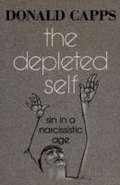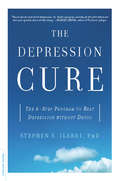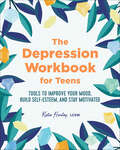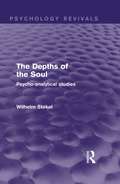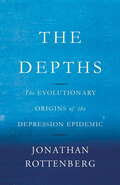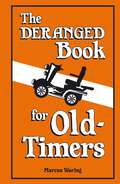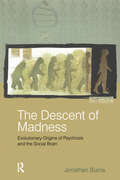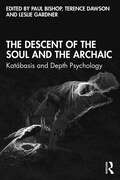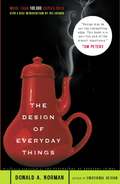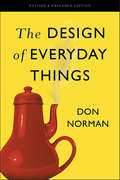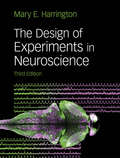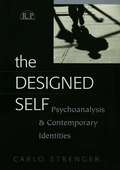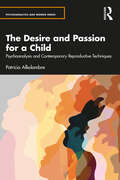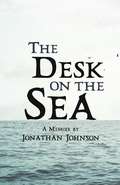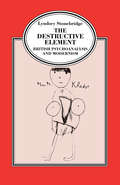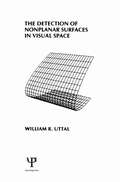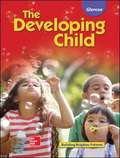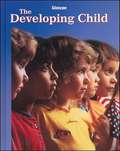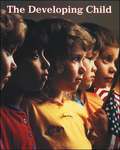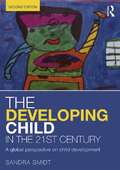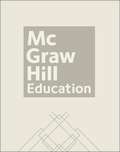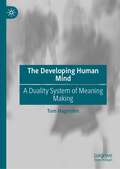- Table View
- List View
The Depleted Self: Sin in a Narcissistic Age
by Donald CappsAlthough narcissism may appear dormant in the 1990s, clinical research on narcissism shows that behind a grandiose, exhibitionistic side lies a shame-ridden half of self-loathing, unworthiness, and depression. Capps says that traditional theologies of guilt are unable to address those gripped by shame and makes a case for a different pastoral approach in counseling and ministry.
The Depression Cure: The 6-step Program To Beat Depression Without Drugs
by Steve IlardiMost Americans work long hours, eat on the fly, and lead increasingly sedentary, isolated lives. Alongside this lifestyle, depression rates have skyrocketed: approximately 1 in 4 Americans will suffer from major depression at some point in their lives. Where have we gone wrong? Dr. Stephen Ilardi sheds light on our current predicament and reminds us: our bodies were never designed for the sleep-deprived, poorly nourished, frenzied pace of twenty-first century life. In fact, our genes have changed very little since the days of our hunter-gatherer ancestors and are still building, in effect, Stone Age bodies. Herein lies the key to breaking the cycle of depression. Inspired by the extraordinary resilience of aboriginal groups like the Kaluli of Papua New Guinea (who rarely suffer from depression), Dr. Ilardi prescribes an easy-to-follow, clinically proven program that harks back to what our bodies were originally made for-and need. Here you can find the road back to lasting health by integrating the following 6 elements into your life: an omega-3 rich diet; exercise; plenty of natural sunlight; ample sleep; social connections; and participation in meaningful tasks that leave little time for negative thoughts--all things that our ancestors had in abundance. Already, The Depression Cure program has delivered dramatic results, helping even those who have failed to respond to traditional medications. Interweaving the stories of many who have fought-and won-the battle against this debilitating illness, this groundbreaking book can illuminate the path to lifting the fog once and for all for you or a loved one.
The Depression Workbook for Teens: Tools to Improve Your Mood, Build Self-Esteem, and Stay Motivated
by Katie HurleyFind relief from depression symptoms with advanced tools for teens ages 12 to 17This depression workbook draws on the most effective and up-to-date techniques, like cognitive behavioral therapy and mindfulness, to deliver simple exercises that help teens learn how to conquer depression.Learn how to identify the differences between normal stress and depression, and find easy exercises designed to help you develop the skills you need to manage your emotional well-being and bring happiness back into your life.The Depression Workbook for Teens includes:Advice for teens—Tackle your depression head-on using strategies written with your unique needs and time constraints in mind.Useful tools—With quizzes, journaling prompts, conversation starters, and more, you'll discover simple skill-building exercises that improve your mood and build your self-esteem.Practical problem solving—Find ways to work through the challenges you're facing, like fighting with your parents, getting up in the morning, struggling with homework, and more.The Depression Workbook for Teens gives you the helping hand you need to get through this difficult time.
The Depths of the Soul: Psycho-Analytical Studies (Psychology Revivals)
by Wilhelm StekelWilhelm Stekel was an Austrian physician and psychologist and one of Freud’s earliest followers. This title, originally published in 1921, was the author’s favourite of his own work. In the preface he says: ‘It was written in the beautiful years in which the first rays of analytic psychognosis penetrated the darkness of the human soul.’ Covering a variety of topics he takes a psychoanalytic look into The Depths of the Soul.
The Depths: The Evolutionary Origins of the Depression Epidemic
by Jonathan RottenbergWhy are we losing the fight against depression? In this groundbreaking work, psychologist Jonathan Rottenberg explains that despite advances in pharmaceutical science, progress has been hampered by our fundamental misunderstanding of depression as a psychological or chemical defect. Instead, Rottenberg introduces a surprising alternative: that depression is a particularly severe outgrowth of our natural capacity for emotion; it is a low mood gone haywire. Drawing on recent developments in the science of mood-and his own harrowing depressive experience as a young adult-Rottenberg explains depression in evolutionary terms, showing how its dark pull arises from adaptations that evolved to help our ancestors ensure their survival. Weaving together experimental and epidemiological research, clinical observations, and the voices of people who have struggled with depression, The Depths offers a bold new account of why depression endures-and points the way toward new paths for treatment.
The Deranged Book For Old Timers
by Marcus WaringThe Deranged Book for Old-timers offers advice on life’s more sedate pleasures, from the afternoon snooze to how to twitch curtains properly. With a guide to being a grumpy codger and a Zimmer frame Kama Sutra, this book is full of delightfully dotty things to do. Yes, we are going to grow old, but we are going to do it disgracefully.
The Deranged Book For Old Timers
by Marcus WaringThe Deranged Book for Old-timers offers advice on life’s more sedate pleasures, from the afternoon snooze to how to twitch curtains properly. With a guide to being a grumpy codger and a Zimmer frame Kama Sutra, this book is full of delightfully dotty things to do. Yes, we are going to grow old, but we are going to do it disgracefully.
The Descent of Madness: Evolutionary Origins of Psychosis and the Social Brain
by Jonathan BurnsDrawing on evidence from across the behavioural and natural sciences, this book advances a radical new hypothesis: that madness exists as a costly consequence of the evolution of a sophisticated social brain in Homo sapiens. Having explained the rationale for an evolutionary approach to psychosis, the author makes a case for psychotic illness in our living ape relatives, as well as in human ancestors. He then reviews existing evolutionary theories of psychosis, before introducing his own thesis: that the same genes causing madness are responsible for the evolution of our highly social brain. Jonathan Burns’ novel Darwinian analysis of the importance of psychosis for human survival provides some meaning for this form of suffering. It also spurs us to a renewed commitment to changing our societies in a way that allows the mentally ill the opportunity of living. The Descent of Madness will be of interest to those in the fields of psychiatry, psychology, sociology and anthropology, and is also accessible to the general reader.
The Descent of the Soul and the Archaic: Katábasis and Depth Psychology
by Terence Dawson Leslie Gardner Paul BishopThe Descent of the Soul and the Archaic explores the motif of kátabasis (a "descent" into an imaginal underworld) and the importance it held for writers from antiquity to the present, with an emphasis on its place in psychoanalytic theory. This collection of chapters builds on Jung’s insights into katabasis and nekyia as models for deep self-descent and the healing process which follows. The contributors explore ancient and modern notions of the self, as obtained through a "descent" to a deeper level of imaginal experience. With an awareness of the difficulties of applying contemporary psychological precepts to ancient times, the contributors explore various modes of self-formation as a process of discovery. Presented in three parts, the chapters assess contexts and texts, goddesses, and theoretical alternatives. This book will be of interest to scholars and analysts working in wide-ranging fields, including classical studies, all schools of psychoanalysis, especially Jung’s, and postmodern thought, especially the philosophy of Deleuze.
The Design of Everyday Things
by Don NormanFirst, businesses discovered quality as a key competitive edge; next came service. Now, Donald A. Norman, former Director of the Institute for Cognitive Science at the University of California, reveals how smart design is the new competitive frontier. The Design of Everyday Things is a powerful primer on how--and why--some products satisfy customers while others only frustrate them.
The Design of Everyday Things: Revised and Expanded Edition
by Don NormanOne of the world's great designers shares his vision of "the fundamental principles of great and meaningful design", that's "even more relevant today than it was when first published" (Tim Brown, CEO, IDEO). Even the smartest among us can feel inept as we fail to figure out which light switch or oven burner to turn on, or whether to push, pull, or slide a door. The fault, argues this ingenious -- even liberating -- book, lies not in ourselves, but in product design that ignores the needs of users and the principles of cognitive psychology. The problems range from ambiguous and hidden controls to arbitrary relationships between controls and functions, coupled with a lack of feedback or other assistance and unreasonable demands on memorization. The Design of Everyday Things shows that good, usable design is possible. The rules are simple: make things visible, exploit natural relationships that couple function and control, and make intelligent use of constraints. The goal: guide the user effortlessly to the right action on the right control at the right time. The Design of Everyday Things is a powerful primer on how -- and why -- some products satisfy customers while others only frustrate them.
The Design of Experiments in Neuroscience
by Mary E. HarringtonUsing engaging prose, Mary E. Harrington introduces neuroscience students to the principles of scientific research including selecting a topic, designing an experiment, analyzing data, and presenting research. This new third edition updates and clarifies the book's wealth of examples while maintaining the clear and effective practical advice of the previous editions. New and expanded topics in this edition include techniques such as optogenetics and conditional transgenes as well as a discussion of rigor and reproducibility in neuroscience research. Extended coverage of descriptive and inferential statistics arms readers with the analytical tools needed to interpret data. Throughout, practical guidelines are provided on avoiding experimental design problems, presenting research including creating posters and giving talks, and using a '12-step guide' to reading scientific journal articles.
The Designed Self: Psychoanalysis and Contemporary Identities (Relational Perspectives Book Series #27)
by Carlo StrengerWhat can contemporary psychoanalysis bring to the understanding of Generation X, a cohort for whom the trivialization of a dizzying array of possible experiences teamed with the pressure to lead spectacular lives often leads to diffuse feelings of confusion, depression, and disorientation. The Designed Self chronicles Strenger's therapeutic encounters with five extraordinarily gifted young adults for whom the ideal of authenticity long associated with the Baby-Boom generation was supplanted by the need to experiment endlessly with the self. Perpetual self-experimentation, constantly reinforced by the media, came to encompass everything from career choice, to hair color, to body shape, to gender identity. In compelling clinical stories, Strenger introduces us to patients for whom the project of shaping the self had become a cultural imperative no less than an expression of individuality. At once insightful and cautionary, The Designed Self investigates how psychoanalysis must change if it is to claim cultural relevance and therapeutic effectiveness in The Age of the Designed Self.
The Desire and Passion for a Child: Psychoanalysis and Contemporary Reproductive Techniques (Psychoanalysis and Women Series)
by Patricia AlkolombreIn this book, Patricia Alkolombre explores the desire for a child from a contemporary psychoanalytic perspective, and covers the questions raised in the face of new resources offered by reproductive medicine. This volume reviews traditional psychoanalytic conceptualisations from the perspective of gender theories and analyses theoretical hegemonies related to the desire and passion for a child. Alkolombre discusses how the ‘passion to have a child’ is a key aspect of motherhood, characterised by emotional intensity, persistence, and self-sacrificial aspects. The book is divided into three sections: Part One deals with the desire and passion to have a child, while Part Two focuses on the impact of reproductive techniques, as well as the ever-changing role of parenthood in the modern day. Throughout these fascinating chapters, clinical vignettes of both individual and couple analyses span topics such as mourning, the use of reproductive technology, the anonymity of gamete donors, enigmatic infertility, surrogacy, and abortion from an interdisciplinary perspective. The historical and cultural contexts of infertility are reviewed from a psychoanalytic angle in Part Three with the view of transcending the former androcentric perspective that has deeply influenced the maternal ideal and expectations of men. Alkolombre also proposes a new analysis of the Oedipus myth. This book is vital reading for psychoanalysts, mental health professionals, teachers and students interested in contemporary parenting, motherhood, and infertility, as well as the theoretical analysis of the desire for a child.
The Desk on the Sea (Made in Michigan Writers Series)
by Jonathan JohnsonThe Desk on the Sea begins four years after American poet Jonathan Johnson spread his mother’s ashes in her beloved Lake Superior and moved with his wife and young daughter into a seventeenth-century cottage on Scotland’s North Sea. On an idyllic, desolate coast and in the wild Highlands, Johnson began his search for a way to live through ongoing grief and to take in the wonder of each new day. Through years of extraordinary suffering by way of multiple ailments, Johnson’s mother, Sheila, endured an astounding number of amputations—a toe, the end of a finger, a foot, whole fingers, the other foot. What she lost in her physical being, she gained in her kindness and generosity. By the time she was told that the only way she could survive a little longer was the amputation of both hands, she was capable of giving those who loved her and herself a beautiful death instead. Inspired by her example of grace and awareness, Johnson and his family gave themselves one year on the coast of Scotland to live by Shelia’s great, guiding principle: We don’t get the days back. They wandered trails along windswept shores and past the stone ruins left by people who’d come and gone before. They played as characters from Harry Potter on deserted beaches. From their cottage, they watched an island lighthouse, counting the seconds between flashes to know exactly when to say "goodnight" so the lighthouse would answer with a wink. The Desk on the Sea is a chronicle of progress toward one man’s new life goal—to be a father, husband, and poet worthy of his mother’s legacy. Sustained by an unwavering belief that words can help us fully occupy our lives, and that imagination and empathy can transform suffering into what John Keats called "soul-making," Johnson offers readers a raw look at love and loss.
The Destructive Element: British Psychoanalysis and Modernism (Language, Discourse, Society Ser.)
by Lyndsey StonebridgeFreud's account of the sublimated drives at work beneath the surfaces of advanced societies, alongside the modernist fictions of Joyce, Proust, Kafka, Woolf and others, both reflected and inaugurated a strain of modernism preoccupied with the darkest elements of the human psyche. In The Destructive Element Lyndsey Stonebridge examines the career and legacy of British psychoanalyst Melanie Klein as a lens through which to examine the 20th century's fascination with death drives, the sublimation of civilization's discontents and the socialization of children--fascinations that would surface throughout the cultural production of the West. At once cultural history and psychoanalytic theory, and a bold reformulation of the legacies of modernism, The Destructive Element is an essential contribution to our understanding of the Western tradition.
The Detection of Nonplanar Surfaces in Visual Space
by W. R. UttalFirst published in 1984. Routledge is an imprint of Taylor & Francis, an informa company.
The Developing Child (9th Edition)
by Holly E. BrisbaneIn studying children, you will read about them, observe them, talk with them, play with them, and help them. In the process, your understanding of children will grow.
The Developing Child 8th Edition
by Mcgraw-Hill Staff Holly E. BrisbaneGive your high school students an understanding of children, parenting. . . and themselves. This leading text examines the skills a parent or caregiver needs in order to nurture successful growth and development in a child.
The Developing Child in the 21st Century: A global perspective on child development
by Sandra SmidtOffering a sociocultural approach to education and learning, this fascinating exploration of childhood provides an in-depth understanding of how children make sense of the world and the people in it. Examining the ways in which children express their thoughts, feelings and actively generate meaning through experience and interaction, this fully revised and updated new edition is illustrated throughout by extensive case studies and covers a diverse range of topics, including: socio-historical and global child development over time and place; the child as meaning-maker and active learner; learning in the context of family, culture, group, society; representing and re-representing the world; understanding roles, identity, race and gender; making sense of science and technology; the implications of neuroscience. Taking a clearly articulated and engaging perspective, Sandra Smidt draws upon multiple sources and ideas to illustrate many of the facets of the developing child in a contemporary context. She depicts children as symbol users, role-players, investigators and creative thinkers, and follows children's?progress in forming their understanding of their environment, asking questions about it, and expressing it through music, dance, art and constructive play. Highly accessible, and with points for reflection concluding each chapter, The Developing Child is essential reading for teachers, lecturers and students taking courses in early childhood, psychology or sociology.
The Developing Child, 13th Edition
by Denise Boyd Helen BeeThrough The Developing Child, 13e Helen Bee and Denise Boyd generate excitement about scientific inquiry by connecting research with applications. All integrated features within the text are designed to engage students and provide them with the support they need to understand, learn, and apply the material.
The Developing Child: Student Activity Manual
by Mcgraw-Hill GlencoeWorkbook for The Developing Child
The Developing Human Mind: A Duality System of Meaning Making
by Tom HagströmThis book proposes a developmental theory of human mind as a basic interaction system of meaning making elements - so called dualities - progressing in dialectical shifts towards higher self-awareness. It elaborates on why this system has developed evolutionary, how it develops in the life courses of humans in modern societies and what hampers and promotes its progression to meet contemporary and future societal challenges.
